Sharing the journey of my good friend Mick Brown who has transformed himself into a fat burning and bullet proof elite runner. Read on and learn some life lessons from a wise Aussie.
………………….
“We are all experiments of one.” Dr Mark Cucuzzella.
Weight has always been an issue for me. Running has always been a means by which I’ve been able to control my weight.
As age catches up, however, one must learn the hard way that something must give.
This is me back in 2005. I was visiting Sydney, having moved to the US from Singapore the previous year. As you can see, I was feeding in a nice, lush paddock, and it showed on the scales, when I was weighing in at around 245 lbs.
Running has been a constant part of my life, whether it be for competitive reasons or just to stay fit. When I went to Finland on exchange as a plump 16-year-old in 1988, I re-discovered cross-country skiing, which helped me shed most of my excess weight and set me up for my final year of school back in Australia where I lettered for 1,500m & 3,000m as well as cross-country.
That was the end of my competitive running for a while. In my mind, I was never going to be elite or even sub-elite, so I started lifting instead, putting on 35 lbs in only a few months. I continued to run for fitness, and despite my heavier weight, I was still able to break 18:00 for 5km in subsequent years in my 20’s, although my overall fitness started to decline as the years went by.
In 2009, I decided on a whim that I wanted to run a marathon. It wasn’t just any marathon either. It was Big Sur http://www.bsim.org , the spectacular route in California which starts in the town of the same name, features a 2-mile climb of 580 feet up Hurricane Point, and finishes in Carmel. I completed it in April 2010, with a time of 3:42:08. Because I weighed around 225 lbs that day (per the photos below), my time is one of the efforts of which I am most proud.
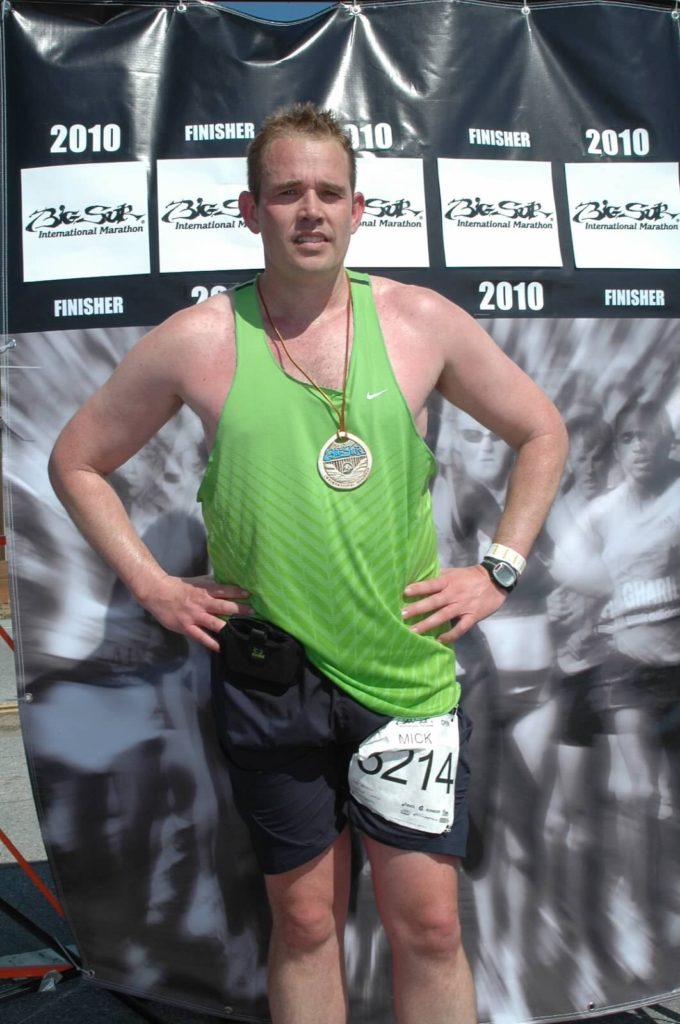
From that point, I was hooked. In October 2010, I ran Outer Banks in a time of 3:38:29 and then I was accepted to run Boston in 2011 for charity. That was when I started to take my training more seriously. Because I was still over 220 lbs, it was important not to over train, and so I started to take a lot more yoga, including running-specific classes with Rebecca Pacheco, http://www.runnersworld.com/yoga-center , who, to this day, is one of the best yoga teachers I’ve ever encountered. Rebecca, an avid runner herself, knew how to structure sequences specific to the needs of runners, and I’m thankful that my love of yoga has not diminished since.
Boston 2011 was a wake-up call, however. On a perfect weather day, when the winner set a world-best, I only managed to improve my PR by a little under 5 minutes, with a time of 3:33:53. I had been doing hill workouts every Tuesday evening in the Boston Common and running with a group on Saturdays for my long runs, cross-training with yoga and spinning classes. However, I was disappointed with the seeming lack of progress even as I was getting leaner. From a nutrition standpoint, I was starting to learn more about hitting the dreaded ‘wall’ and how 2 bagels with butter on race morning probably weren’t sufficient to carry me through the race.
It was after Boston 2011 that I became a lot more serious about my training. After reading the first few chapters of Born to Run by Chris MacDougall, I made the hasty decision to switch to Vibram-5 fingers. This was at the height of the so-called minimalist craze. Soon after making the change, my times really started to improve. In the space of only a few weeks, my PR for 10km dropped from 43:55 to 39:10. Later that year, I moved to Chicago and, in the interests of learning to run with correct form, I took a Chi Running http://www.chirunning.com course with Danny Dreyer. The day after that course, my PR for the half dropped from 1:31:19 to 1:29:08, and then down to 1:23:49 only a few weeks later. With my PR for the marathon dropping from 3:33:53 (Boston 2011) to 3:08:08 in Philadelphia 2011, everything seemed set to take off. There was still no structure to my program and it was on 3 days a week with copious amounts of yoga. I thought yoga was the perfect cross training which would also offset the lack of miles.
2012 saw continued improvements. In my mind, it was all because of the Vibrams. They made me faster. There was a purple patch in September/ October, when I ran 17:02 for 5km, 2:59:41 for the Chicago Marathon and then, only 2 weeks later, 1:20:57 for a half. This was still on 3 days a week at a weight of around 190 lbs. Feelings of invincibility started to manifest themselves. That was when I signed up for Comrades Marathon http://www.comrades.com in South Africa, the world’s oldest and largest ultramarathon. It necessitated moving up to 4 days a week of training, as time on feet is paramount when training for that event, given the duration and the dramatic changes in elevation.
My time at Comrades in what were exceedingly hot conditions was a respectable 9:23 for 54 miles; however, my Chicago 2012 qualifying time, which garnered me an A seeding, did not extrapolate even closely to a predicted 7:30 finish.
The post-Comrades period was when things started to go wrong.
Although I took a few weeks off after Comrades, training that summer and into the autumn was a grind. By now, I was up to 5 days a week, and the cumulative fatigue meant that training was no longer fun. I was still only slightly off my PRs, but I thought that I should be improving at a much greater rate. Chicago 2013 rolled around, and I thought I was at least in sub-2:55 shape, which I was on pace to hit, when I suffered a stress fracture of the 5th metatarsal which kept me out of running for a couple of months. I’ll come back to what I now think is the reason for that injury later in this post.
When I resumed training for Boston 2014, I was determined to regain my previous level of fitness. It didn’t matter what I did. Those previous performances seemed so far away. I was no longer running in the Vibrams because I couldn’t run pain-free if I wore them. I was convinced that the Vibrams explained the delta in my times, so I tried to compensate in other ways. I had my last alcoholic drink in June of 2014. The weight dropped off but progress was still slow.
It was around this time that I became aware of the work of Professor Tim Noakes, the famous (or infamous, depending on your views of Prof Noakes) exercise physiologist in South Africa. When you run Comrades, it’s impossible not to encounter Prof Noakes in one of the many forums devoted to training for that event. Prof Noakes was writing about the concept of insulin resistance, that if you run to control your weight, you are likely insulin resistant. Prof Noakes confirmed this was likely the case for me when he answered a question I posed on his website: http://www.thenoakesfoundation.org/nutrition-network/do-you-run-to-control-your-weight-you-may-be-insulin-resistant
I only wish I had followed his advice more stringently back then.
Around the same time, I struck up an email friendship with Dr Mark, whom I met for the first time at the American Medical Athletic Association Conference http://www.amaasportsmed.org in Boston just before the marathon in 2014. We stayed in touch as I attended his Healthy Running Course in Chicago the following year, and after I moved to D.C. in 2016.
2015 and 2016 saw some improvements across the board. I dropped my 5km PR to 17:00, my 8km PR by 34 seconds to 28:00, my 10km PR by 1:50 to 36:06 and my marathon PR from 2:59:41 to 2:58:12 (Boston 2015) and then to 2:54:52 (Philadelphia 2016).
Despite this, it seemed that it was becoming more difficult to maintain my level of performance, even though I was running 6 days a week and still taking care of myself with regular massage and yoga. I was also becoming frustrated with the fact that my times over the shorter distances did not reflect what was in those race predictor tables for the half and the full.
When I look at my PRs over the shorter distances, what stands out is that they come nowhere near close to predicting what should be my half and marathon PRs. Tools such as the Jack Daniels vdot calculator https://runsmartproject.com/calculator/ should not be the be all and end all when it comes to predicting performance, but the fact that my times were not lining up indicated that there was likely a problem with nutrition, or training paces, or both.
After the Philadelphia Marathon in November, 2016, I took a couple of weeks off running, and I fell in a heap. I was sick for a couple of weeks, after which I resumed running in early December. On the day of the marathon, my weight was 180 lbs. There was no weight gain during the enforced rest but when I weighed myself on New Year’s Day this year, I had put on 9 lbs. This weight gain occurred as I was ramping up my mileage. For whatever reason, I had an epiphany that day and I resolved to eliminate added sugar completely from my diet. I had to take that absolutist approach, as Prof Noakes urges for people with sugar addictions. This is a lifestyle change. Eschewing sugar and other unhealthy, processed foods for a period of time and then gradually re-introducing them into the diet will not work for me. It’s an all or nothing proposition.
What has been the impact of that one change?
This year alone, I’ve raced 4 times over 10 miles and completed 2 marathons which I ran/ walked.
The first 10-miler was a club race and only a week into my no sugar experiment. 1:02:51 was my time on a snowy day when I didn’t have any expectations (my PR was 1:00:17, set in 2013). Between that race and the subsequent RRCA 10-Mile challenge 7 weeks later, I did not ramp up mileage significantly, although I re-introduced quality workouts (tempo and track) and I PR’d by 23 seconds with a time of 59:54. The following week, I ran the Reston 10-Miler as a controlled effort with a massive negative split (I was not looking to PR) and then a couple of weeks later, I completed the Shamrock Marathon in Virginia Beach in 3:03:28, run/walking (35 steps each mile). It was my 4th fastest marathon out of the 13 I had completed.
All this time, I was adhering to the no sugar diet, becoming acutely aware of the ‘traps’ of added sugar, particularly at conferences where the choices are limited. My one weakness, with which I continue to struggle, is my proclivity for bread. Given my abstention from desserts and pastries and that I haven’t had a drink in almost 3 years, one vice is probably not too detrimental to my program.
What happened in the next month only served to validate that I was on the right track. 2 weeks after Shamrock, I completed the Cherry Blossom 10-Miler in 59:20, shaving another 34 seconds off my PR, and 2 weeks later, I finished the Western Maryland Rail Trail Marathon, a small, well organized event in Hancock, MD, in 3:02:49, also run/walking, making that my 4th fastest marathon.
Here’s a picture of me during the Cherry Blossom 10-Miler and another immediately after finishing the Western Maryland Rail Trail Marathon:
On the day of writing this, I am 178 lbs. That’s 67 lbs lighter than when I started training for the marathon back in 2009.
As Deming famously remarked “In God we trust. All others bring data.” For me, while the race times showed significant progress, I wanted incontrovertible proof that the changes in diet were having a physiological impact. Dr Mark had shared the results of the V02 max test he took at Fort McNair in February in a blog post to which I refer regularly: http://naturalrunningcenter.com/2017/03/07/burn-fat-health-performance-better-butter-burner/
Dr Mark has pre- diabetes. Mark had spent years hoovering down cereal at all hours of the day (and night), as he operated in the mistaken belief that carbohydrates were de rigeur for continued elite performance. This focus on burning sugar rather than fat meant that he was pounding his pancreas to the degree that he was barely able to produce insulin. Mark’s own research led him to make drastic changes to his diet, embracing the low carb, high fat approach that has been espoused by Prof Noakes and Dr Phil Maffetone https://philmaffetone.com for years now.
In his V02 max test taken last February, compared with the one a year earlier, the data showed that Mark’s fat burning capabilities had increased significantly, to the extent that he was burning fat at 90% of his theoretical maximum heart rate. As he remarked to me on the adaption from burning carbohydrates to fat, “this is not a quick process.”
My results were equally encouraging. After only 3 ½ months of zero sugar, when I took the test, my V02 max was 66. My aerobic threshold (aet), the rate at which I am optimally burning fat before switching to burning carbohydrates, is 143 beats per minute at 7:54 mile pace. My lactate threshold (LT), or the intensity of exercise at which lactate begins to accumulate in the blood at a faster rate than it can be removed, is 157 beats per minute at 6:07 pace. LT is a pace which I should be able to sustain for 75 minutes in a race. Ideally, as my fat burning capabilities improve at a higher percentage of my max, I should also see an increase in pace at those same heart rates.
So, what has worked me?
1. Diet has had the most profound impact on my training and performance. To think that it has taken me till now, at the age of 44, 6 years after my first marathon to realize that I had been handicapping myself by not paying the proper attention. I may as well have strapped on a weight-loaded vest, such was the impact on my performance and recovery. After 4 months of a lower-carb, high fat diet, my energy levels are significantly higher and it’s liberating that I don’t have to worry about carbo loading before a race because I’m becoming fat adapted. I eat red meat twice a week and fish features prominently for me in my diet. For personal reasons, I don’t eat chicken or pork anymore. Previously, I felt that I was at an age where I would start slowing down. I now feel that I have several more years of improved performance left in me, provided I continue to eat healthily and stay injury-free.
2. Fueling: Before I head out the door in the morning for a run, I rarely eat anything. I like training on an empty stomach. I don’t take sports drinks (because of the sugar) or gels, and I rarely consume water unless it’s hot and humid.
3. Mileage and training paces: I’ve never been a high-mileage person. At my weight, I know I’m pushing the limits if I exceed 60 miles in a given week, especially if I incorporate track and tempo sessions. At the same time, I’ve learned to slow down on my easy days and for my long runs. There’s no point in my bounding around on a 20-miler at sub-7 pace. Even though you might feel great, your body is not making the correct adaptations, particularly when mitochondrial development occurs at slower paces. Running slower to get faster is an axiom to which I’m trying to adhere. Returning to the question of why I was injured after Comrades, I have no doubt that the high volume of ‘quality’ miles and the fact that I thought I should be running around 7:00 pace on my easy days contributed to the gradual wearing down of my body which in turn led to a degradation of form. It’s poor form which causes injuries, not footwear. Hearing first-hand from Phil Maffetone how a combination of a diet high in processed carbohydrates, coupled with training at an intensity which is too high has reinforced the importance of slowing down to get faster. A poor diet will cause an inflammatory response, making it more difficult to recover from quality workouts on the track or tempos on the road. Having the data from my V02 max test also informs the heart rate zones at which I’m operating in ‘no-man’s land’. A few beats per minute can make the world of difference, between optimizing fat for fuel and burning sugar. Too long in the sugar-burning zone does not allow for any positive adaptations, meaning that those miles are effectively ‘junk’. I love my slow miles on easy days or long run days. They’re typically 8:00 pace or slower, meaning that my HR does not go above 141. I highly recommend referring to Phil’s article on Maximum Aerobic Function (MAF) as a guide to establishing correct heart rate training zones: https://philmaffetone.com/maf-test/
4. Footwear: As stated above, it’s poor form which causes injuries, not footwear. I subscribe to the viewpoint that you should run with the minimal amount of shoe that lets you run injury and pain-free. For me, that would be the Merrell Bare Access 4. This is a zero-drop, neutral shoe with a wide toe-box. I rotate through 3 pairs so that I’m not running in the same pair on consecutive days. For races, I like the Merrell Vapor Glove or the Topo Athletic ST-2, both zero-drop with a wide toebox. I like to feel the road, and these shoes let me do that. I’m not saying that these shoes are suitable for everybody, nor do I intend to enter the minimalist versus maximalist debate in this forum. Suffice it to say that I have a conscious focus on efficient running form (once again, courtesy of Dr Mark and Danny Dreyer) and that shoes will never compensate for poor form. I do think it’s worth pointing out, however, that the American College of Sports Medicine, has issued guidelines in which they recommend minimal drop, neutral shoes, with a wide toe box. These guidelines can be found here: https://www.acsm.org/docs/brochures/running-shoes.pdf I’ve also started wearing Correct Toes https://www.correcttoes.com/ during my runs, so that my toes are spaced appropriately and to optimize foot function. At a recent Healthy Running Course in San Luis Obispo, I was fortunate to meet the founder of the company, Dr Ray McClanahan, a podiatrist who takes an integrated approach to healing his patients. Ray doesn’t just treat the symptom or the injury. He endeavors to understand what structural or mechanical issues are the root cause in order to help his patients run injury-free.
5. Run/Walking: For all but races and speed workouts, I employ the run/ walk methodology espoused by Jeff Galloway http://www.jeffgalloway.com Even in non-goal marathons which I am using for training, I run/ walk. It’s amazing how much it preserves the legs and aids in recovery. Some of my fastest marathons, 4 of my 12 Boston Qualifiers, have been run/ walk efforts, including 3:02, a 3:03, a 3:05 and a 3:06. I’m a big fan of Galloway. He has helped thousands of people enjoy pain-free running. I’m sold!
6. Core exercises: Most mornings, before I head out for my run, I do some basic core exercises to activate the muscles I’m about to use. It takes 5 minutes. That’s it. I also do some hip opening exercises given to me by the South African chiropractor, Dr Lawrence van Lingen http://www.innerunner.com Lawrence is one of those people, like Mark, whom many might consider to be out of the mainstream. Read what he says, watch his videos. It all makes so much sense. Lawrence doesn’t advocate foam rolling or stretching but he does say that having supple hips and leveraging the natural ‘springiness’ with which we are endowed will help us run injury-free.
7. Coaching: I’ve been working with the same coach, Chris Wehrman, for almost three years now. Chris was a 2:19 marathoner back in the day (22nd in Boston in 2002) who went to the Olympic Trials in 2004 and 2008. Having a coach takes a lot of the thinking out of the process for me. I have friends who self-coach, relying on books by Pfitzinger, Jack Daniels or the Hanson Brothers and they’ve had amazing results. That doesn’t work for me, as I need somebody who will keep my impulses in check. It took some months before we finally clicked, but I am grateful for Chris’ guidance.
These pieces are what I’ve managed to put together over the years. Much of this is the result of fortuitous meetings as well as trial and error. It’s not rocket science. The answer is right there: healthy diet, correct form, slowing down, strong core and active recovery. There’s no magic pill or supplement. I’m the experiment of one!
I’m thankful to Dr Mark for welcoming me into his community. Nobody does more for the pursuit of running than Mark. Nobody contributes more to his community in terms of education and public health advocacy. His Freedom’s Run Marathon and Half-Marathon and the Harper’s Ferry Half-Marathon http://freedomsrun.org are true community events in which he seems to have a knack of co-opting volunteers of all ages to ensure successful events. I’m glad to count him as a friend.

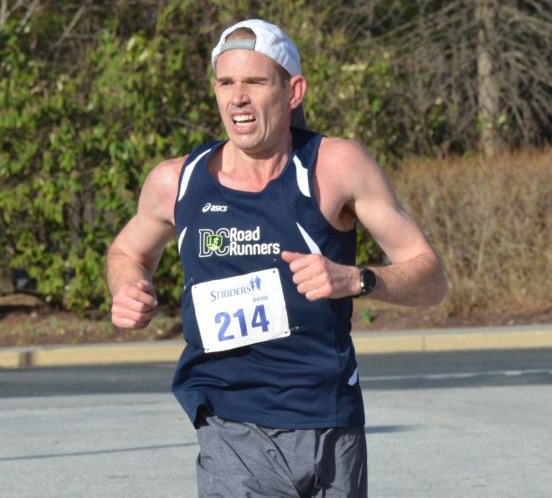
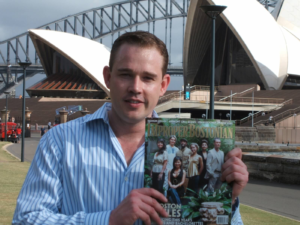
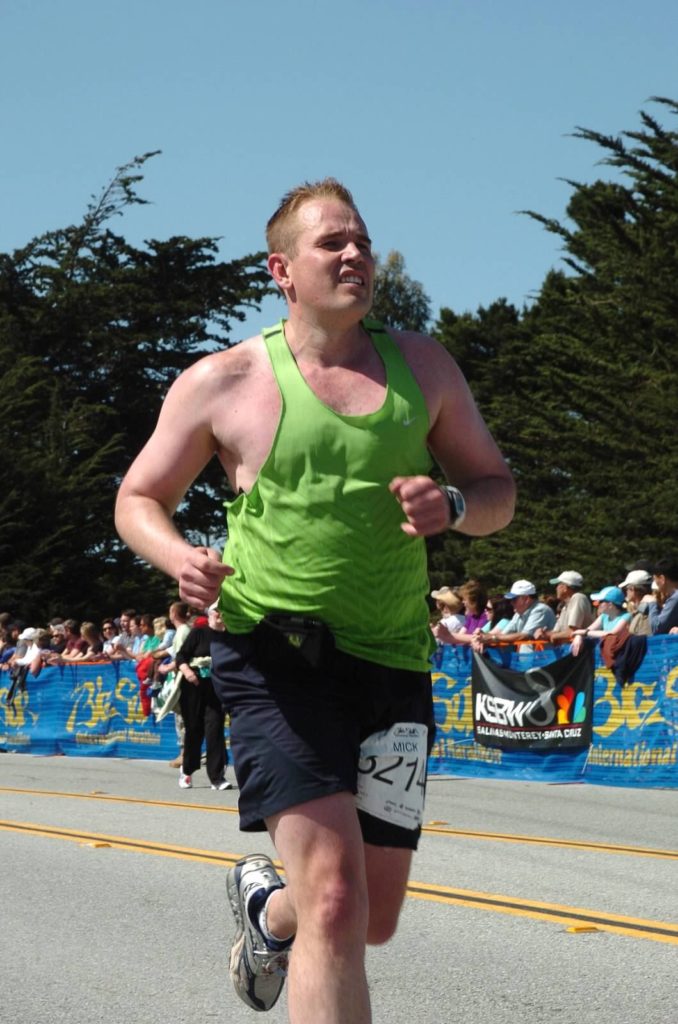
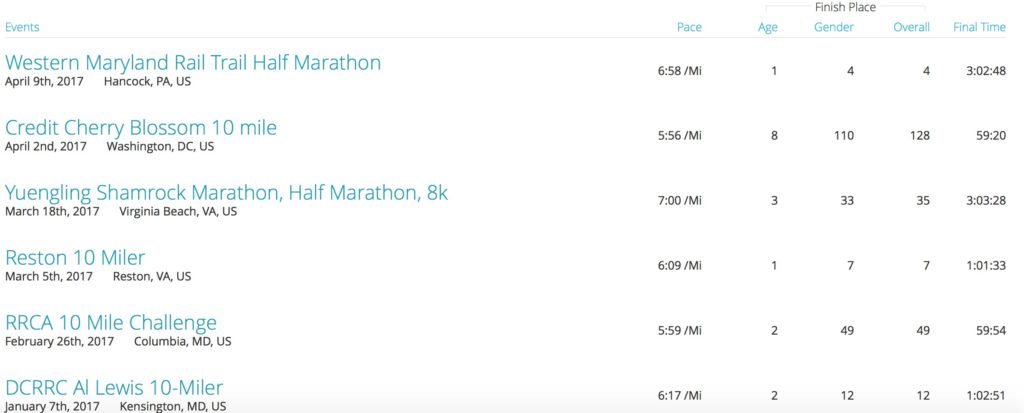
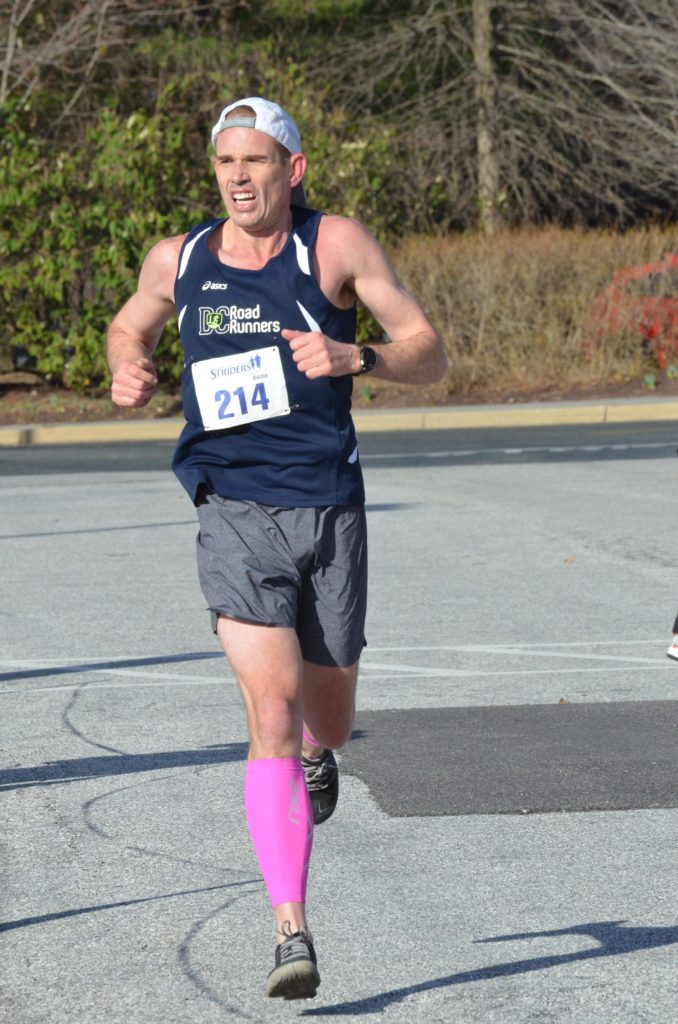
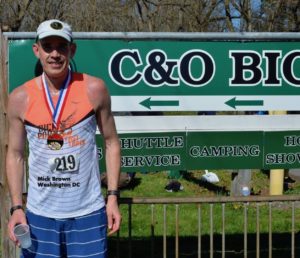

Great article Mick. Congrats on your determination, focus and achievements thus far. An inspirational journey from which all could learn a valuable lesson. I sense further gains / accomplishments in the horizon.
Loved the post Mick. Thanks for sharing your story. Really inspiring. Looking forward to continue watching your transformation.
Thanks for sharing your journey…very insightful and you are just getting started!
Thanks for sharing your story. There is a lot to learn from this great article.
Amazing transformation Mick. Congratulations and well done for continuing to evolve, learn and improve.